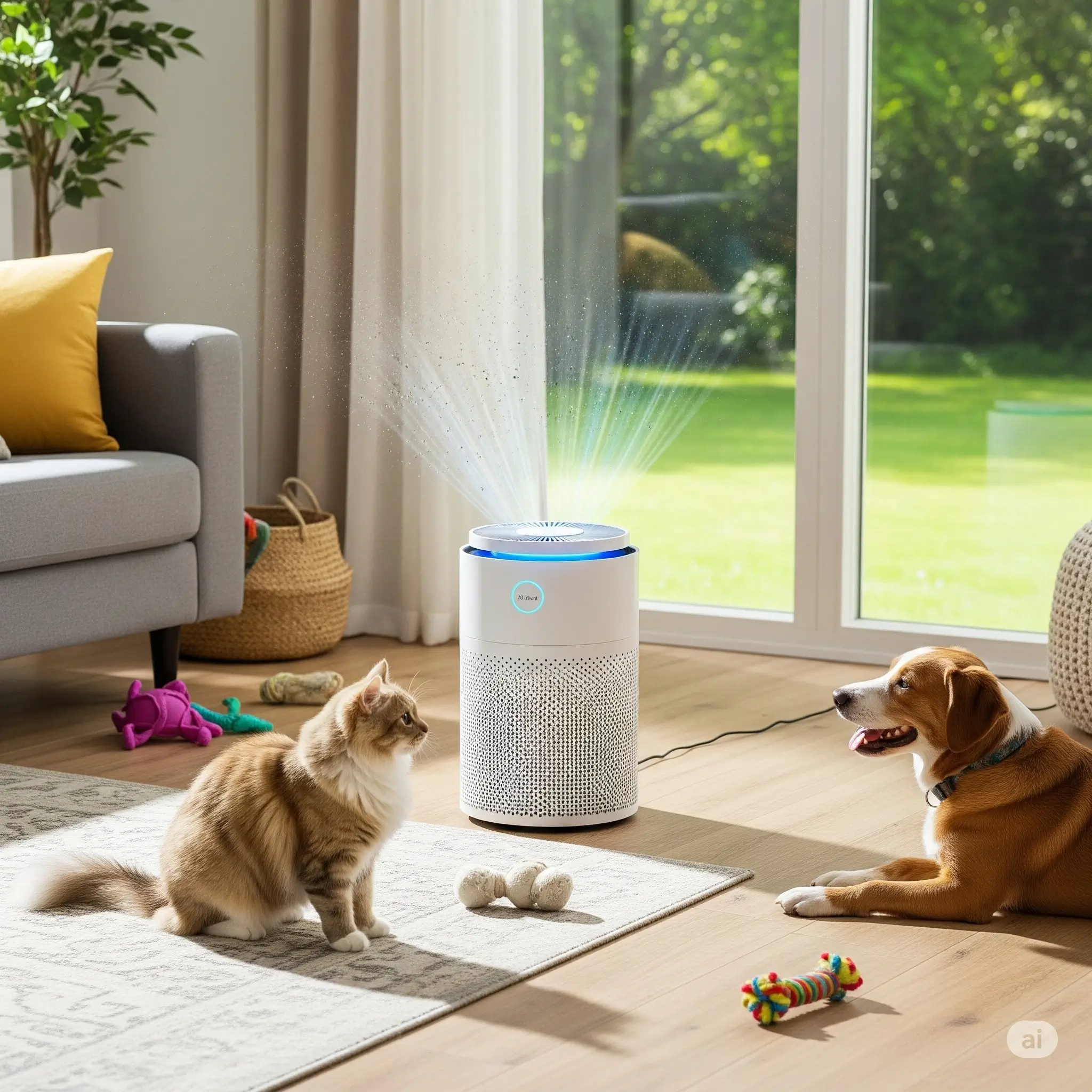
Dust. It’s everywhere, right? You see it dancing in sunbeams, coating your furniture, and, for many of us, causing sneezing fits and itchy eyes. If you’re dealing with allergies, asthma, or just want unsoiled air in your home, finding the right air purifier for dust mites is a big deal. It’s not just about making things look clean it’s about breathing easier. We’ve looked into what makes an air purifier for dust mites really effective against those tiny dust invaders and the allergens they bring.
Key Takeaways
- True high efficiency particulate air filters are a must for capturing 99.97 % of tiny particles, including dust mite waste, which is a common allergy trigger.
- Look for air purifiers with a high Clean Air Delivery Rate (CADR) for your room size to ensure quick and effective dust removal.
- Multi stage filtration, often including a pre filter and activated carbon, helps capture larger dust, pet dander, and odors.
- Consider the Air Changes per Hour (ACH), aim for at least 4 ACH to keep the air purified and reduce dust effectively.
- Pay attention to noise levels and filter replacement costs, as air purifiers for dust mites often need to run continuously.
True HEPA Filtration
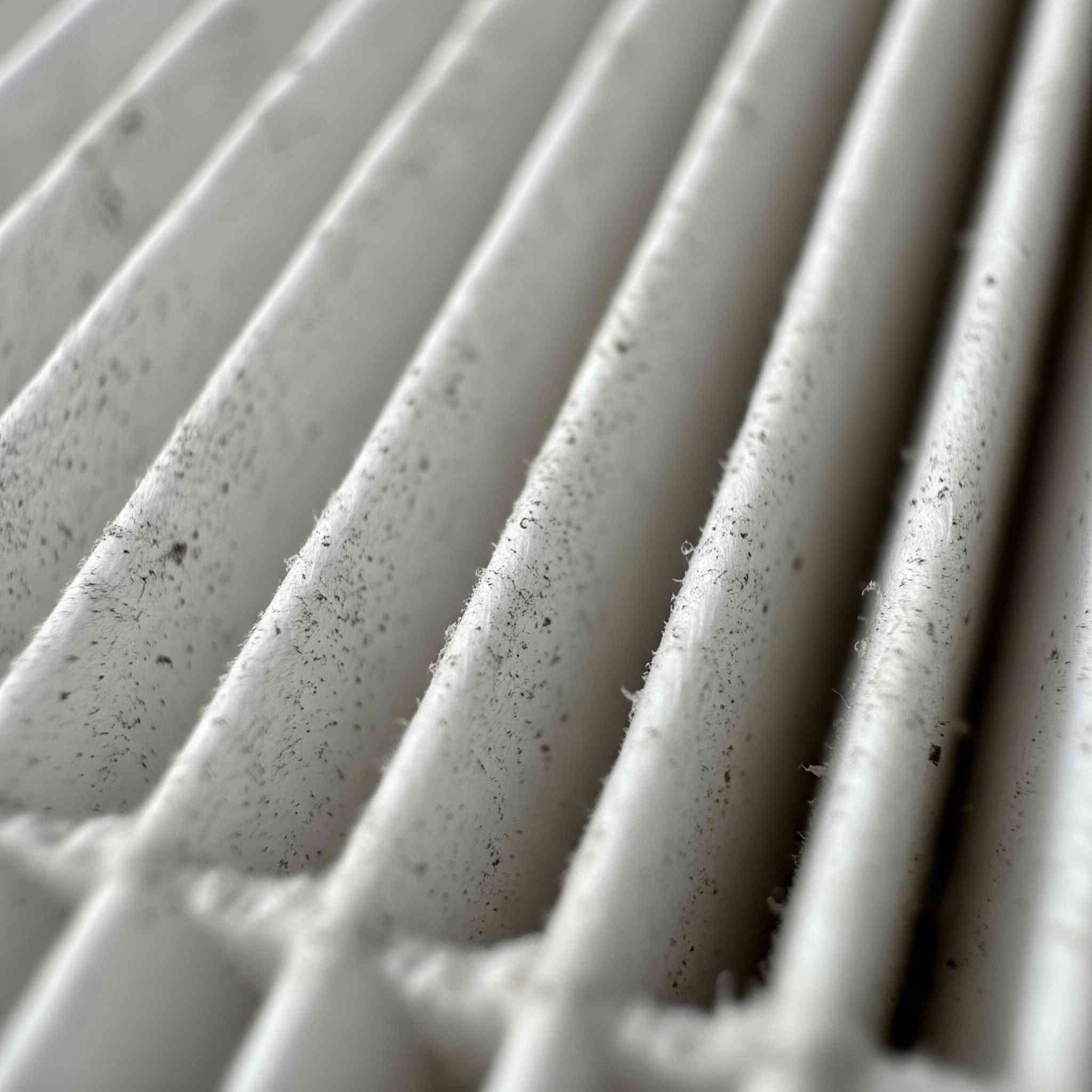
When you’re trying to get rid of dust mites, the kind of filter inside an air purifier really matters. The gold standard here is a True HEPA filter. What does that actually mean? Well, it’s a pretty strict standard.
A True HEPA filter has to capture at least 99.97 % of airborne particles that are as small as 0.3 microns. Think about that, that’s incredibly tiny. For some perspective, a human hair is usually between 20 and 180 microns wide. Dust mite allergens themselves are typically around 10 to 40 microns. So, a True HEPA filter is designed to grab almost all of those pesky little allergens that float around in your air.
It’s important to know that not all filters labeled ‘HEPA’ are created equal. Some might be ‘HEPA-type’ or ‘HEPA-like’, which don’t have to meet the same rigorous standards. You really want to look for the ‘True HEPA’ designation to be sure you’re getting the best performance against dust mites and other fine particles. This type of filtration is super effective because it physically traps these particles as air passes through the filter material. It’s a straightforward, reliable way to purify your air.
The physics behind how HEPA filters work means they’re actually even better at capturing particles that are larger or smaller than that 0.3 micron mark. So, while 0.3 microns is the benchmark, the filter’s effectiveness extends beyond just that specific size.
Multi-Stage Filtration Systems

When you’re really trying to tackle dust mites and all the other tiny stuff floating around your home, a single filter might not cut it. That’s where multi stage filtration systems come in. Think of it like a team of filters, each with its own job, working together to purify your air.
Most good air purifiers designed for allergies will have at least three stages. First up is usually a pre filter. This is the first line of defense, catching the bigger particles like pet hair and larger dust clumps. It’s important because it helps protect the more sensitive filters down the line, making them last longer.
After that, you’ll typically find a True HEPA filter. We’ve talked about these already, but they’re the real workhorses for capturing those super fine particles, including dust mite allergens, pollen, and mold spores, down to 0.3 microns. Finally, many systems include an activated carbon filter. This one is great for tackling odors and gases, like those from cooking or cleaning products, which can sometimes make allergy symptoms feel worse.
The idea behind a multi stage system is simple: capture as much of the bad stuff as possible by using different types of filters for different sizes and types of pollutants. It’s a more thorough approach than relying on just one filter type.
Here’s a quick look at what you might find:
- Pre-filter: Catches larger particles like hair and lint.
- True HEPA Filter: Captures 99.97 % of particles 0.3 microns and larger.
- Activated Carbon Filter: Absorbs odors and VOCs (volatile organic compounds).
Some advanced units might even add extra stages, like specialized filters for VOCs or even UV-C light for killing germs. It really depends on what you’re trying to target, but for dust mites, a solid three stage system with a good HEPA filter is usually the sweet spot.
Activated Carbon Filters
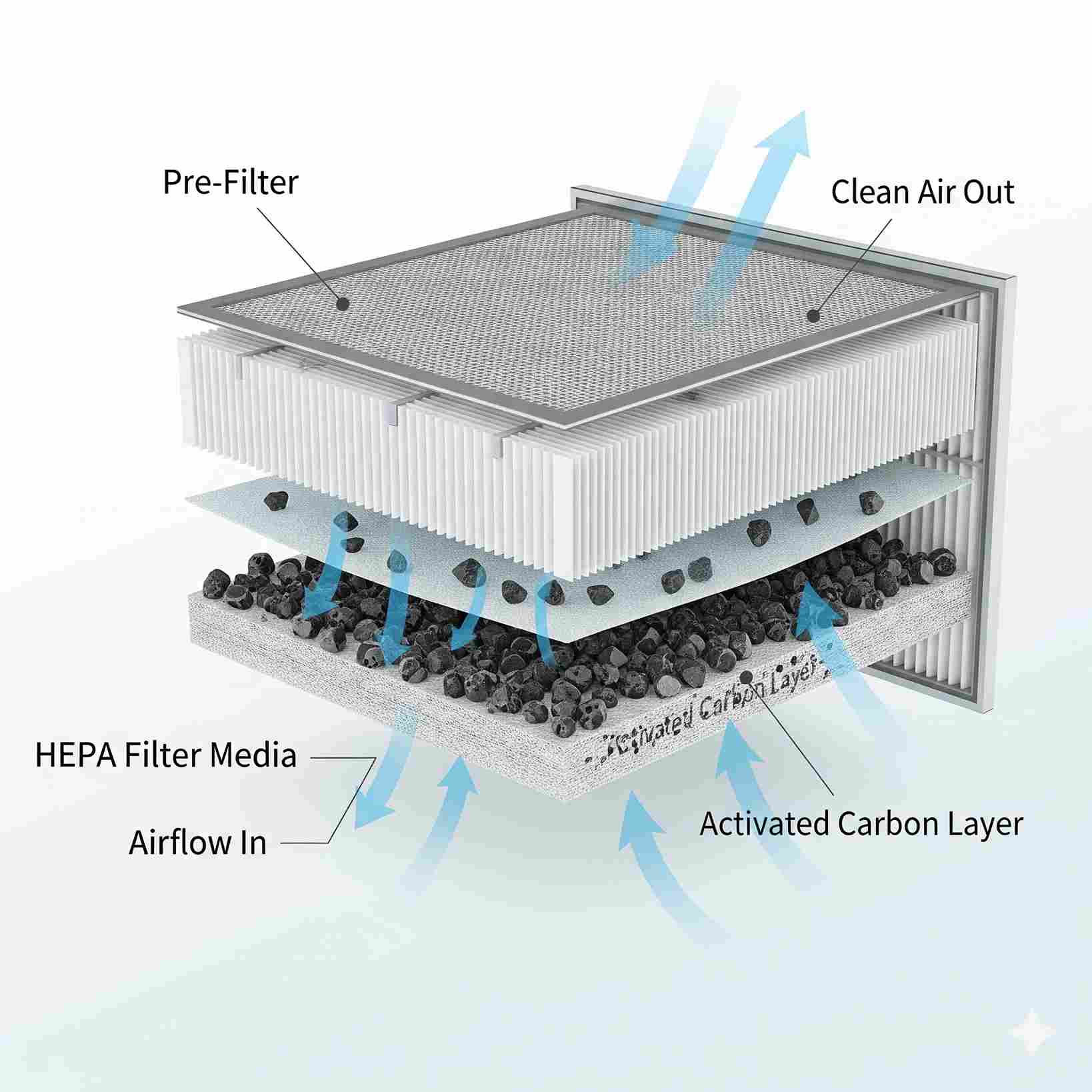
Beyond just trapping physical particles, air purifiers often include activated carbon filters, and these are pretty important for tackling smells and gases. Think about cooking odors, pet smells, or even those chemical fumes that can waft off new furniture, activated carbon is designed to grab onto those. The carbon’s countless microscopic pores trap unwanted gases and smells through a process known as adsorption, binding them firmly to its expansive surface.
Household activated carbon filters excel at capturing volatile organic compounds, sweeping these invisible pollutants out of your indoor air. These can come from all sorts of everyday items, like cleaning supplies, air fresheners, and even certain building materials. While HEPA filters are great for dust mites and pollen, they don’t do much for these gaseous pollutants. That’s where carbon filtrate really shine.
Here’s a quick look at what they target:
- Odors: From cooking, pets, smoke, and general staleness.
- Gases: Like formaldehyde, benzene, and other VOCs released from household products.
- Chemical vapors common with fresh furniture, electronics, or household cleaners, linger as that sharp “new” or “clean” smell.
Most purifiers stack multiple stages of defense: a pre filter to snag large debris, a HEPA layer to trap microscopic particles, and an activated carbon bed to lock away odors and gases. This multi stage approach means you get protection against both physical particles and airborne gases.
For instance, a purifier might use its pre filtrate for larger debris like pet hair, the HEPA filter for dust mites and allergens, and the activated carbon filtrate for lingering smells and VOCs. This layered defense is why looking at the overall filtration system is a good idea when you’re shopping around.
Clean Air Delivery Rate (CADR)
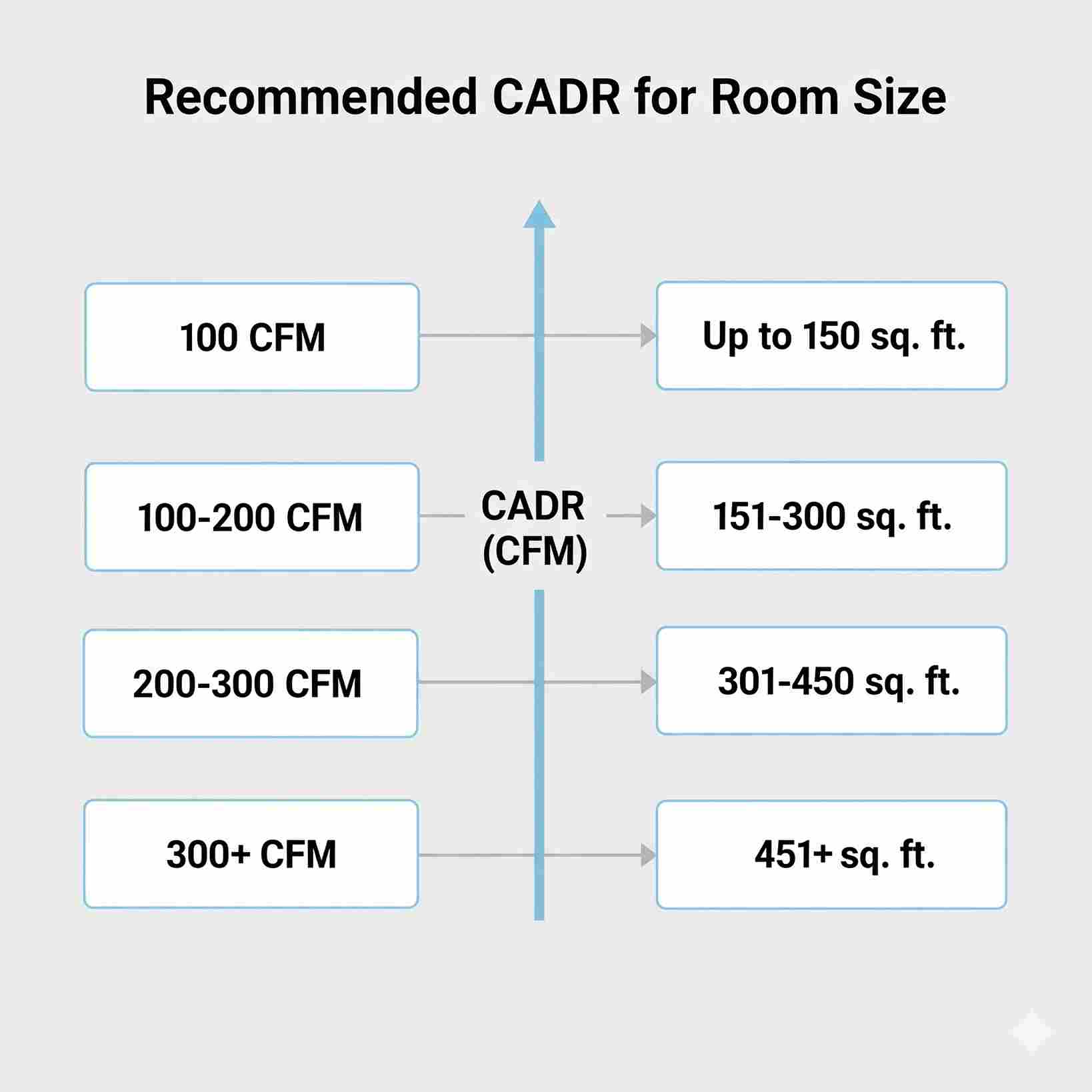
When you’re looking at air purifiers, especially for dust, you’ll see something called CADR, which stands for Clean Air Delivery Rate. Think of it as a speed rating for how fast the machine can purify the air in a room. A higher CADR number means it’s working faster and doing a better job of removing stuff like dust.
Basically, the CADR tells you how much clean air the purifier puts out. Airflow is typically gauged in cubic feet per minute, CFM for short.. For dust, you’ll often see specific CADR ratings for that. So, if a purifier has a dust CADR of 200, it means it can purify the air in a 200 square foot room of dust in about an hour. It’s a good way to compare different models.
Here’s a general idea of what CADR numbers might mean for dust:
- Small rooms (under 150 sq ft): Look for a dust CADR of at least 100.
- Medium rooms (150–350 sq ft): Aim for a dust CADR of 150–250.
- Large rooms (over 350 sq ft): You’ll want a dust CADR of 300 or higher.
Be sure to choose a CADR that fits the square footage of your room. Using a purifier that’s too small for your space means it will have to work extra hard and might not keep up with the dust. On the flip side, an oversized unit might be overkill and more expensive than you need.
The general advice is that your air purifier’s CADR should be at least two thirds of the room’s area in square feet. So, for a 300 square foot room, you’d want a CADR of at least 200.
Particulate Matter 2.5 (PM2.5)

When we talk about air purifiers and dust mites, we often focus on the mites themselves, but it’s also about what they leave behind. Dust mites produce waste particles, and these, along with other tiny bits floating around, are what trigger allergies. This is where PM2.5 comes into play.
PM2.5 describes airborne particles no wider than 2.5 micrometers so small they are barely visible under a microscope. Think of things like smoke, vehicle exhaust emissions, bacteria, and yes even the tiny waste products from dust mites.
Because they’re so small, they can easily get deep into your lungs, causing irritation and worsening allergy symptoms. Air purifiers that can effectively capture these minuscule particles are key to creating a cleaner breathing environment.
Here’s a quick look at why PM2.5 matters:
- Tiny enough to dwarf even a strand of human hair they’re roughly 1⁄30 its width.
- Source: They come from a variety of places, including combustion (like car engines and fires), industrial processes, and biological sources like bacteria and dust mite allergens.
- Health Impact: Due to their size, they can bypass your body’s natural defenses and reach deep into your respiratory system, potentially causing inflammation and exacerbating conditions like asthma and allergies.
When you’re shopping for an air purifier, look for models that specifically mention their ability to purify PM2.5. This usually means they have a good quality HEPA filter, which is designed to trap particles of this size and even smaller. It’s not just about the dust mites themselves, but the whole package of tiny irritants they contribute to the air you breathe.
Air Changes Per Hour (ACH)

So, you’ve got your air purifier, and it’s got that fancy HEPA filtrate. Great, ut how often is it actually purifying the air in your room? That’s where Air Changes per Hour, or ACH, comes in. Think of it like this, if a room has 1000 cubic feet of air, and your purifier can clean 1000 cubic feet of air every hour, it has an ACH of 1. It’s basically telling you how many times the purifier can cycle all the air in a given space within a 60 minute period.
For tackling dust mites and other tiny irritants, you really want a purifier that can do a good job of circulating and purifying the air frequently. Most experts suggest aiming for at least 4 ACH in the rooms where you spend the most time, like your bedroom or living room.
In practical terms, the unit fully refreshes the room’s entire air supply four times each hour.. Some purifiers can even hit 5 ACH or more, which is even better if you’re dealing with a lot of dust or have sensitivities.
When you’re looking at specs, you’ll often see a CADR (Clean Air Delivery Rate) number. You can use this to figure out the ACH for your specific room size. Generally, a higher CADR means a higher ACH for a given room. It’s not just about the filtrate’s ability to catch particles, but also the machine’s power to move that air through the filtrate and around your space.
Here’s a rough idea of what ACH levels mean:
- 1–2 ACH: Okay for very light use or very large rooms where frequent cleaning isn’t the main goal.
- 3–4 ACH: A solid baseline for most living spaces and bedrooms, providing decent air cleaning.
- 5+ ACH: Ideal for allergy sufferers, dusty environments, or small rooms where you want the air cleaned as quickly and often as possible.
It’s easy to get caught up in just the filtrate type, but the fan power and how it’s designed to move air are just as important for actually getting the dust out of the air you breathe.
UV-C Light
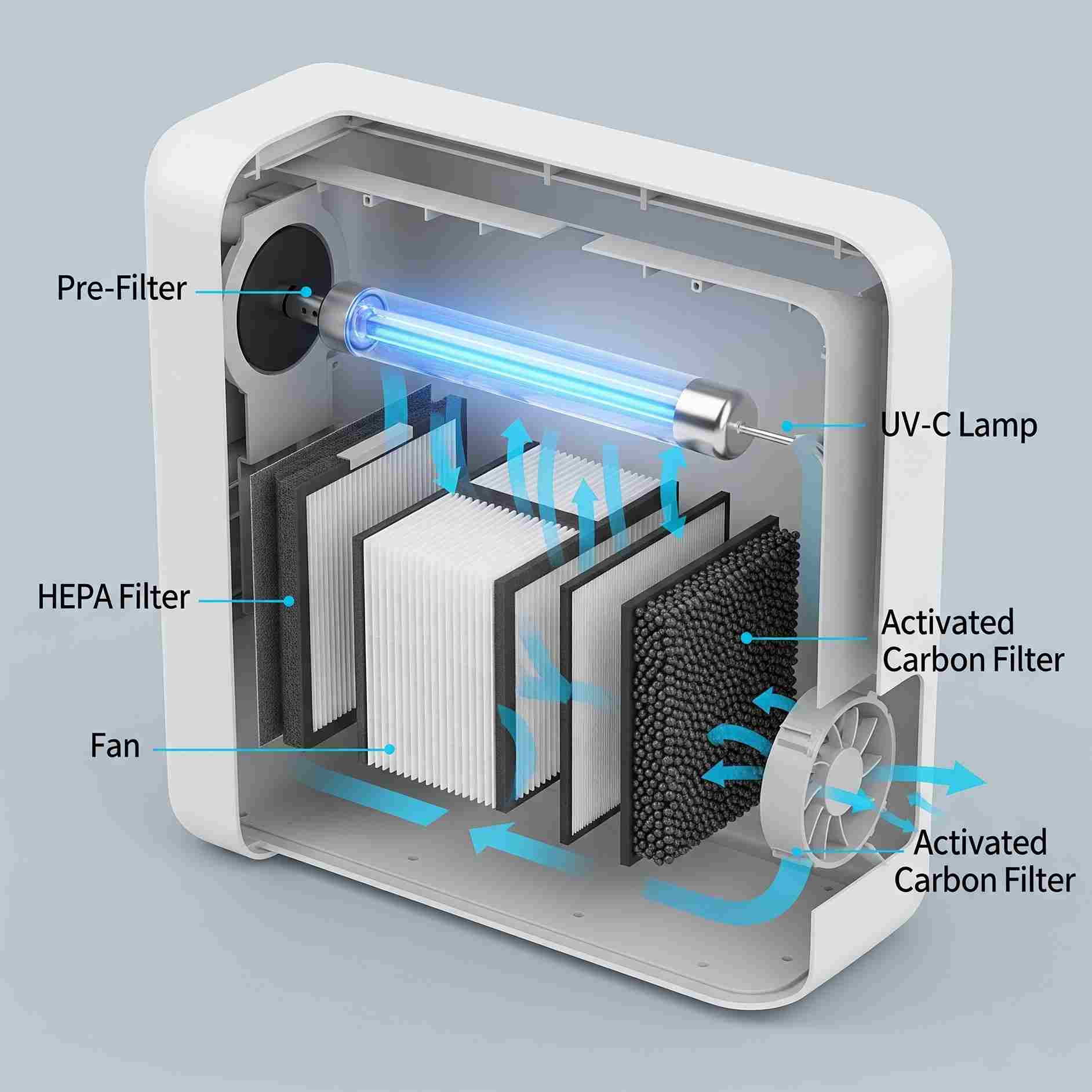
Certain models add an internal UV-C lamp to the filtration lineup. The idea behind this is that the UV-C light can kill off germs and other tiny things floating around in the air, like bacteria and viruses. It’s kind of like a sterilization step after the air has been filtered.
While UV-C light has been around for a while and is used in some medical settings, its effectiveness in typical home air purifiers can be a bit hit or miss. For it to really work well, the air needs to be exposed to the light for a specific amount of time, and the light needs to be strong enough. When air rushes through too quickly, the UV-C light doesn’t get the dwell time it needs to neutralize germs.
Here’s a quick rundown:
- How it works: Air passes over a UV-C lamp, which is supposed to damage the DNA of microorganisms, making them unable to reproduce.
- What it targets: Primarily bacteria, viruses, and mold spores.
Considerations: What matters most is how strong the UV-C beam is and how long the air lingers in its glow. Some units might have a UV-C light that’s more for show than serious germ killing.
- Maintenance: Like other bulbs, UV-C lamps eventually burn out and require replacing, usually about once a year, to keep them working.
It’s important to remember that UV-C light is not a magic bullet for dust mites themselves, as they are larger allergens and not typically targeted by this technology. Its main benefit, if it works well, is in dealing with airborne germs that might accompany dust. Always check the manufacturer’s claims and look for independent testing if this feature is a priority for you.
Ionization Technologies
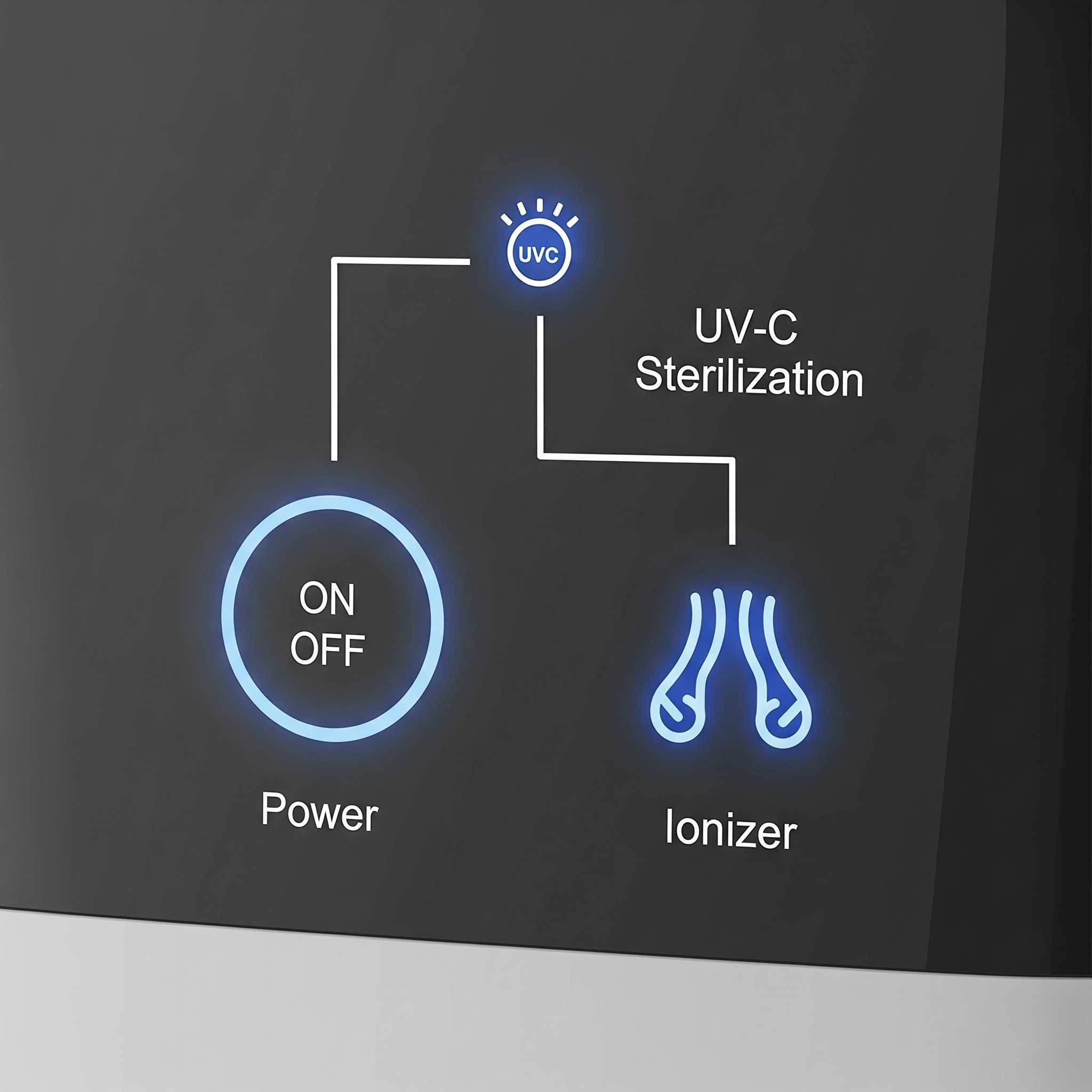
Some air purifiers use ionization as a way to clean the air. This process involves releasing charged ions into the air, which then attach to airborne particles like dust and allergens. The idea is that these charged particles will clump together and become heavier, causing them to fall out of the air and onto surfaces, or get caught more easily by the purifier’s filters.
While ionization can help reduce some airborne particles, it’s not always the best choice, especially if you’re sensitive to air quality. A major concern with some ionizers is their potential to produce ozone.
Ozone is a gas that can irritate the lungs and worsen respiratory problems. Reputable manufacturers usually ensure their ionizers produce very little ozone, often below strict limits set by organizations like the California Air Resources Board, and many models allow you to turn the ionizer off if you prefer.
It’s worth noting that the actual effectiveness of ionizers in capturing particles can vary, and some studies suggest they might not be as efficient as other methods for removing very fine particles. If you’re looking for a purifier primarily for dust mites, which are microscopic allergens that thrive in dust, you’ll want to focus on purifiers with robust filtration systems that can capture these tiny particles.
When considering a purifier with ionization, look for models that:
- Give you the option to switch the ionizer off completely.
- Have been certified to produce minimal or no ozone.
- Clearly state their contaminent removal capabilities, ideally backed by third-party testing.
Remember, while ionization can be a supplementary feature, it shouldn’t be the sole reason you choose a purifier. A good high efficiency particulate air filter is still the most reliable way to capture dust mites and other small allergens from the air. You can find more information on how different filtration methods work on air purifier effectiveness.
Noise Level
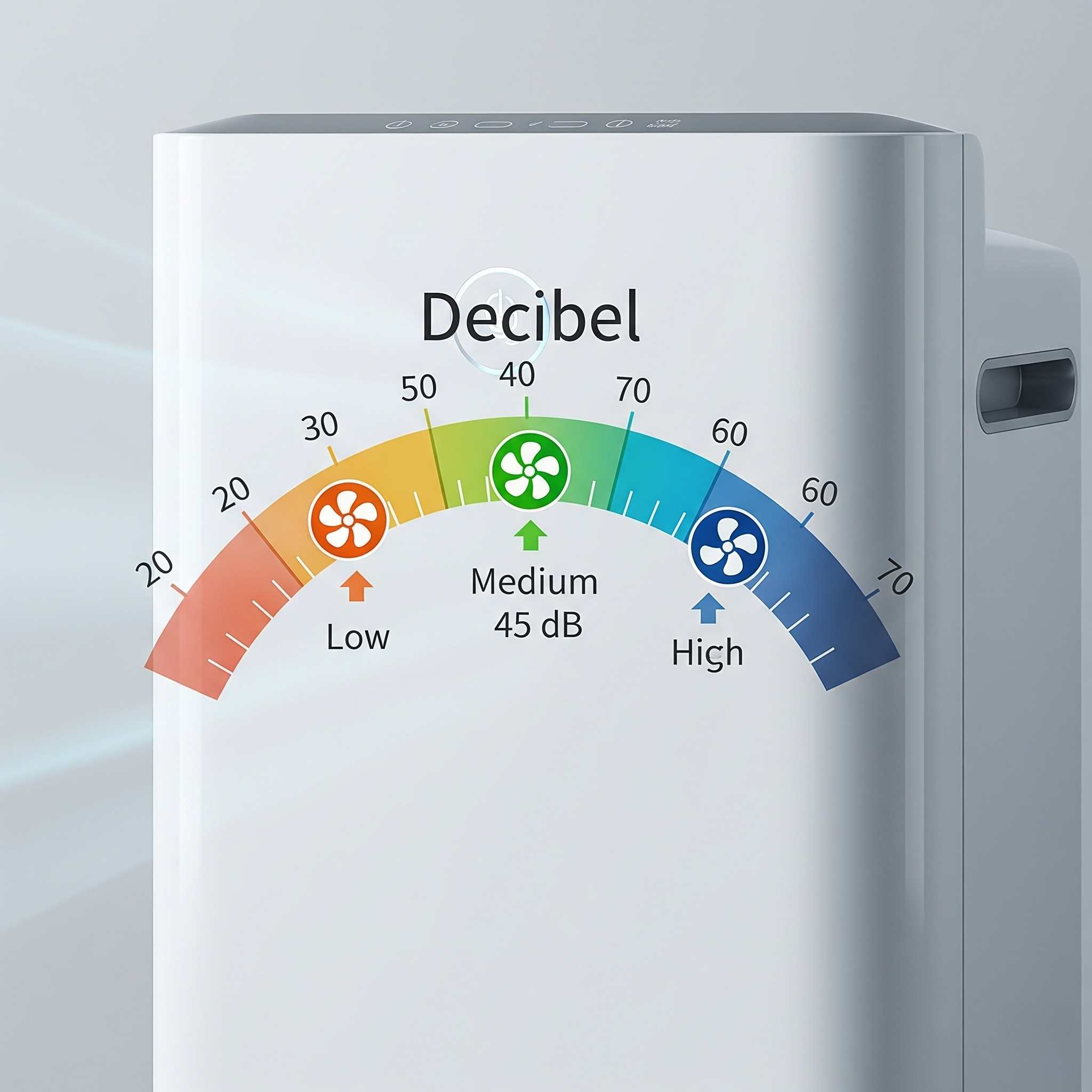
When you’re looking for an air purifier to tackle dust mites, the noise it makes is a pretty big deal, especially if you plan to use it in your bedroom or living area. Nobody wants a constant loud hum or whirring sound in the background, right? The best air purifiers strike a balance between powerful cleaning and quiet operation.
Think about where you’ll place the unit. A purifier that’s fine in a large, open space might be disruptive in a smaller, quieter room. Many purifiers have multiple fan speeds, and the noise level can vary significantly between them. The lowest setting is often barely audible, like a soft whisper, while the highest setting can sound like a tiny fan or even a vacuum cleaner.
Here’s a general idea of what different decibel (dB) levels mean for noise:
- 0–30 dB: Very quiet, comparable to a whisper or rustling leaves. Ideal for bedrooms.
- 30–50 dB: Quiet, like a refrigerator humming or a quiet library. Generally acceptable for most living spaces.
- 50–65 dB: Noticeable, similar to normal conversation or a washing machine. Might be distracting for some.
- 65+ dB: Loud, like a vacuum cleaner or a busy street. Usually too noisy for comfortable use.
Some models even offer a “sleep mode” that automatically lowers the fan speed and dims or turns off the lights, making them much more pleasant for nighttime use. It’s also worth checking if the manufacturer provides specific noise level ratings for each fan speed, as this can help you choose a unit that fits your comfort level. You can find detailed performance data, including noise levels, in resources like Consumer Reports.
Pay attention to the decibel ratings for the lower fan speeds. While high settings are important for quick purifying, you’ll likely use the lower settings most often for continuous air purification. A unit that’s quiet on its lowest setting is a win for everyday use.
Replacement Frequency

So, you’ve got your air purifier humming along, doing its thing to keep dust mites at bay. But what about the filtrate themselves? They aren’t going to last forever, and knowing when to swap them out is pretty important for keeping that air purified. Most manufacturers suggest replacing HEPA and activated carbon filters every 6 to 12 months, but honestly, that’s just a general guideline.
Think about it, if you live in a really dusty area, maybe near a construction site or in a city with lots of traffic, your purifier is going to be working overtime. In those situations, you might find yourself needing to replace filters more often than the average person. It’s kind of like how often you need to change the oil in your car, it depends on how much you drive it.
Some newer systems have smart filters that actually monitor how clogged they are and tell you when it’s time for a change, which is pretty neat. But for most standard units, here’s a quick rundown of what to expect:
- HEPA Filters: These are the workhorses for capturing tiny particles like dust mite allergens. Plan on replacing them roughly every 6–12 months.
- Activated Carbon Filters: These tackle odors and gases. They often have a similar lifespan to high efficiency particulate air filters, so you’ll likely replace them at the same time.
- Pre Filters : If your unit has a washable pre filter, give it a clean regularly, maybe once a month. This helps extend the life of your main HEPA and carbon filters.
Keep an eye on your purifier’s performance. If you notice it’s not moving as much air as it used to, or if you start smelling odors again, those filters might be past their prime, regardless of the calendar.
Don’t forget to factor in the cost of replacement filters when you’re buying your air purifier. Some units have more expensive filters than others, and if you have to buy them every six months, that adds up!
Breathing Easier, Finally…
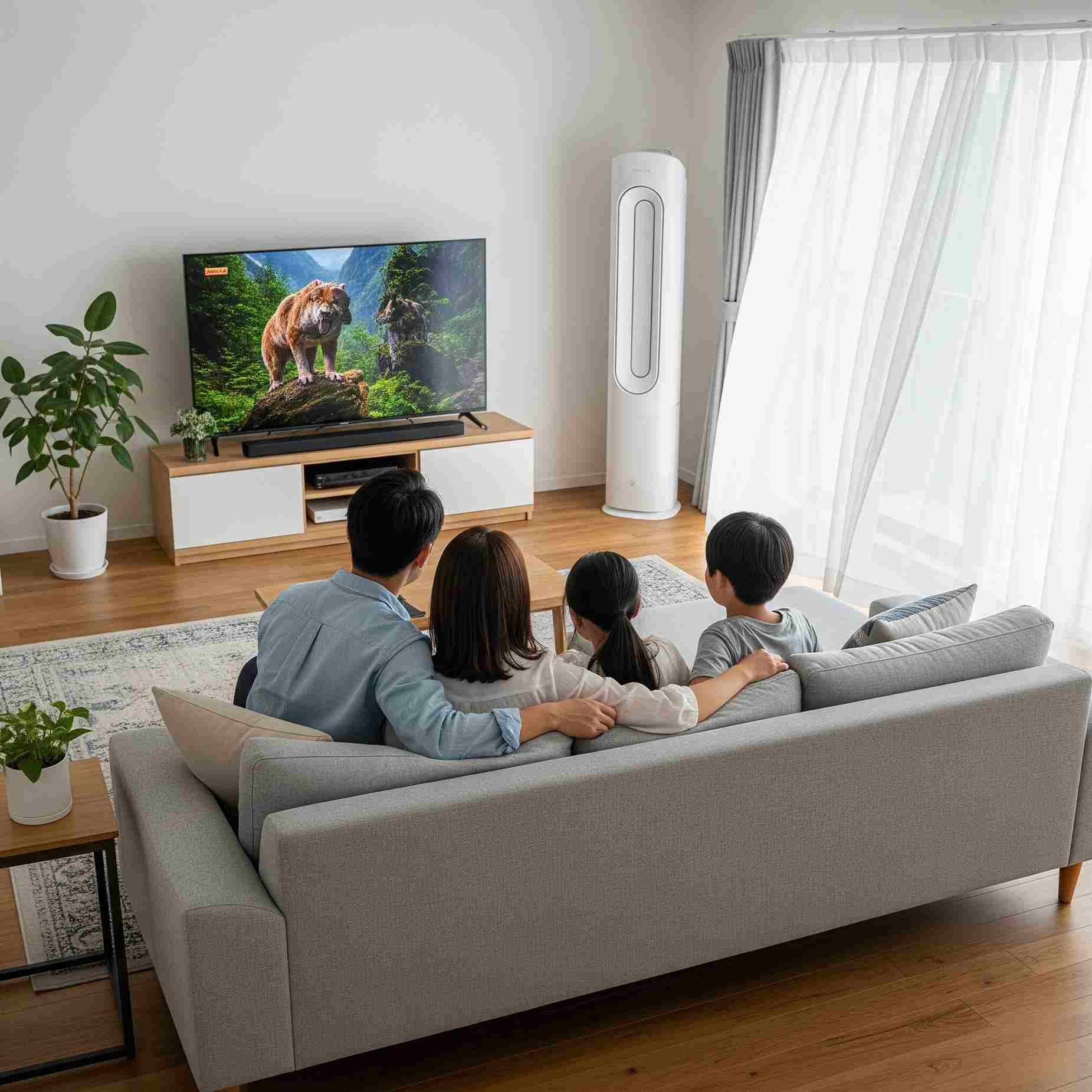
So, picking out the right air purifier for dust mites might seem like a lot, but it really comes down to a few key things. You want that True HEPA filter, no question. It’s the main player in catching those tiny dust particles and the stuff that makes allergy sufferers miserable.
Think about your room size, too,you need something that can actually clean the air in your space effectively. And don’t forget about noise, you’ll want it running a lot, so make sure it’s not going to drive you crazy. Combining a good purifier with regular cleaning habits, like dusting and vacuuming, will make a big difference. You’ll likely notice you can breathe a bit easier and just feel more comfortable in your own home.

